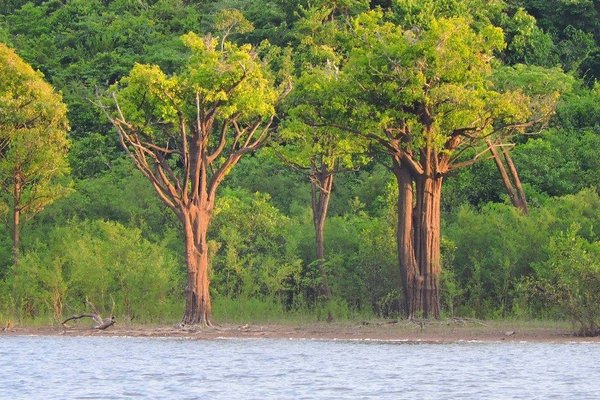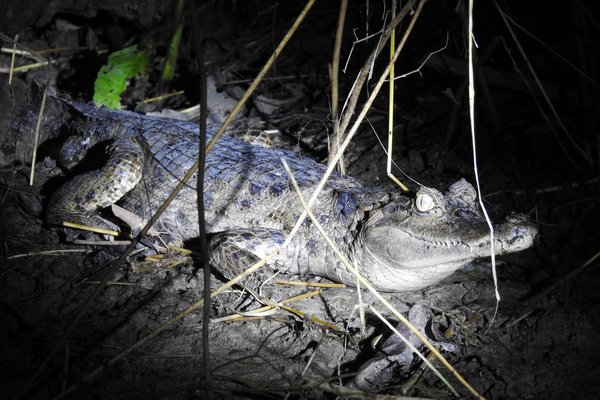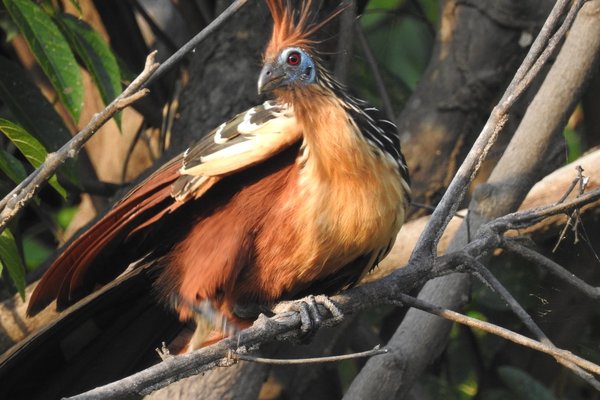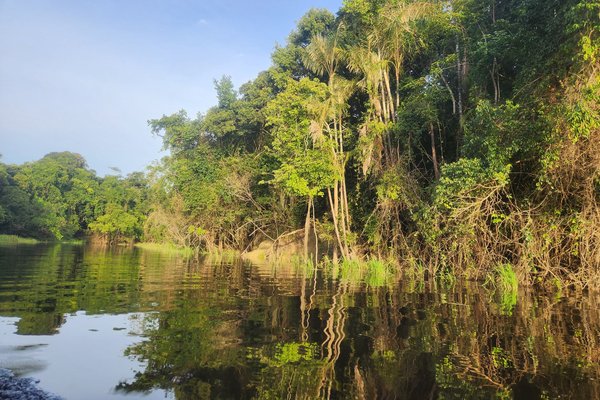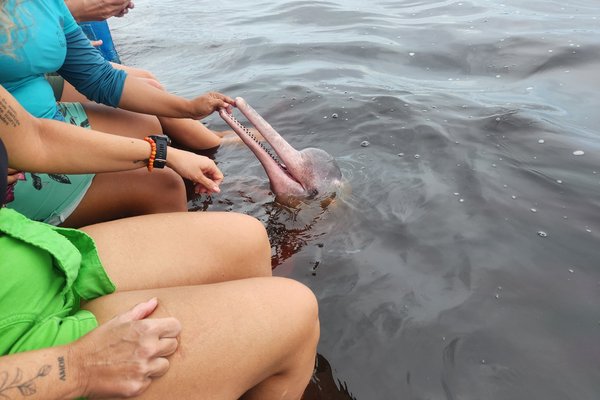Brazil
Central Amazon Conservation Complex
The Central Amazon Conservation Complex comprises four nature reserves, representing the most important ecosystems of the Amazon.
These include várzea and igapó forests, which are seasonally flooded by silty river water, and blackwater rivers, which slowly flow through forested swamps or wetlands. Furthermore, Anavilhanas is the second-largest river archipelago in the world, with some 400 islands. The area is also known for its fish, such as the giant Arapaima, many plant species, and endemic birds.
Community Perspective: the easiest to reach (but possibly also the least rewarding) of the four components is Anavilhanas, which can be done on a two-day trip from Manaus (as done by Frédéric) or as a day trip from Novo Airao (as Patrik did). Els covered Mamiraua, João Jaú NP, and Amana Reserve so far is unreviewed.
Site Info
Official Information
- Full Name
- Central Amazon Conservation Complex (ID: 998)
- Country
- Brazil
- Status
-
Inscribed 2000
Site history
History of Central Amazon Conservation Complex
- 2003: Extended
- Extension of Jaú National Park, to include: the Amana Sustainable Development Reserve, the Demonstration area of the Mamirauá Sustainable Development Reserve and the Anavilhanas Ecological Station
- 2003: Name change
- From "Jaú National Park" to "Central Amazon Conservation Complex"
- 2000: Inscribed
- Inscribed
- Type
- Natural
- Criteria
- ix
- x
Links
- UNESCO
- whc.unesco.org
- Official
-
- icmbio.gov.br — Anavilhanas Ecological Station
- gov.br — Jaú National Park
All Links
UNESCO.org
- whc.unesco.org — whc.unesco.org/
Official Website
- icmbio.gov.br — Anavilhanas Ecological Station
- gov.br — Jaú National Park
Community Information
- Community Category
- Natural landscape: Rivers, Wetlands and Lakes
Travel Information
Recent Connections
-
Oceanic Dolphins
Tucuxi (UNEP-WCMC)
-
Perfect Inscriptions
2000 -
Over 100 mammal species
"high diversity with 120 species of mam…
Connections of Central Amazon Conservation Complex
- Individual People
-
-
Cousteau
1983
-
- Geography
-
-
Archipelagos
"Anavilhanas contains the second largest archipelago of river islands in the Brazilian Amazon" (AB ev) -
Amazon Basin
"the largest protected area in the Amazon Basin" (OUV) - Located primarily at the confluence of the Negro (the largest left tributary of the Amazon River (accounting for about 14% of the water in the Amazon basin)) and Solimões Rivers (upper stretches of the Amazon River)
-
- Ecology
-
-
Siraneans
Amazonian manatee "Numerous species of global conservation concern live within Jau NP, including .....Amazonian Manatee," and Anavilhanas "Here it is easy to see spectacular ildlife, including ...manatees" (AB) -
Eagles
Harpy Eagle (Official description) -
Over 100 mammal species
"high diversity with 120 species of mammals" in Jaú (UNEP-WCMC) -
Otters
Giant Otter -
Crocodiles
Black caiman and Spectacled caiman -
High-Biodiversity Wilderness Area
Amazonia -
Jaguar habitat
"Numerous species of global conservation concern live within JNP, including jaguar" (AB ev) -
Swamps and Marshes
"a significant number of terrestrial and aquatic ecosystems associated with the forest which are periodically inundated by seasonal flooding, as well as swamps." (OUV) -
Fish
Crit x "The "pirarucu" (Arapaima gigas), the largest freshwater fish in South America......... In addition, 64 species of electric fish, which is the strongest known diversity for this group unique in the world, with a circulation range and an adaptation rate comparable to those of cichlids in the African Rift Valley, have been identified in the property" -
Rainforests
"The forest cover of JNP is linked to the extensive and continuous tropical rainforests of the Amazon Central Plain" (AB ev) -
Endemic Bird Species
Amazon flooded forest, Jaú National Park: Chestnut-headed Nunlet (Nonnula amaurocephala), Klages's Antwren (Myrmotherula klagesi)See www.birdlife.org
-
Notable examples of multiple speciation in one site
"The water bodies existing in these reserves (Mamirauá and Amana) contain 64 species of electric fishes in seven families, including 3 species new to science, which represent the highest known diversity of this unique group of organisms in the world, with a level of radiation and adaptation akin to that of cichlids in the Rift Valley of Africa" -
River Dolphins
Amazonian River Dolphin " Expansion of the site also enhance the protection of key threatened species including .... two species of river dolphin." (AB for 2003 extension). But IUCN now only recognises 1 species of Amazonian River Dolphin with 3 sub species -
Turtles and tortoises
Yellow-footed tortoise plus 10 freshwater turtles
-
Salamanders
3 species of worm-salamanders -
Oceanic Dolphins
Tucuxi (UNEP-WCMC)
-
Tapirs
Brazilian tapir -
Sloths
brown-throated sloth, two-toed sloth -
Anteaters
giant anteater, silky anteater, southern tamandua
-
- World Heritage Process
-
-
Natural sites rejected for cultural criteria
Proposed as a cultural landscape in 2003 in the nomination dossier, but no follow-up by ICOMOS -
Perfect Inscriptions
2000 -
Extended
2003: Extension of Jaú National Park, to include: the Amana Sustainable Development Reserve, the Demonstration area of the Mamirauá Sustainable Development Reserve and the Anavilhanas Ecological Station
-
- Human Activity
-
-
Petroglyphs
"petroglyphs at the mouth of the Jaú" (nom file) -
Rubber
History of human occupation - "low-impact......by the soldados da borracha ("rubber soldiers"), who walked the forests of the region in search of rubber sap and game. With the decline of the rubber market, this population migrated to urban centers" (Nomin file)
-
- WHS on Other Lists
-
-
U.S. Ambassadors Fund
Documentation of Amazonian Oral Traditions (2008) -
World Heritage Forest Programme
-
Ramsar Wetlands
Mamirauá, 1993 -
New 7 Wonders of Nature
Amazon -
World Biosphere Reserves
Central Amazon (2001) -
Centres of Plant Diversity
SA5 Manaus region - "the property protects an impressive variety of flora and fauna species"
-
- Timeline
-
-
Pliocene
Aufgrund der damit verbundenen Sperrung des Abflusses kehrte sich vor circa 10 bis 15 Millionen Jahren der Flusslauf um. Weil aber zunächst im Zentrum des Amazonasbeckens eine Hebung stattfand, geschah dies in zwei Phasen: Während die Osthänge bereits über einen Amazonas-Vorläufer in den Atlantik entwässerten, bildeten sich auf der Westseite riesige Binnenseen, deren Ablagerungen heute großenteils den Untergrund der Terra firme ausmachen. Erst als diese Seen nach rund fünf Millionen Jahren ebenfalls nach Osten entwässerten, konnte sich das heutige Flussnetz entwickeln. (Wiki)
-
- Visiting conditions
-
-
No road access
3 hours in a boat are necessary to reach the park entrance of Jau. The 2nd location, Anavilhanas, is closer but also boat only.
-
- WHS Names
-
-
Name changes
From Jaú National Park (2003) -
Named after a River
Amazon
-
- Literature & Film
-
-
Featured in the Go Jetters
Series 1: Episode 19: The Amazon rainforest
-
News
No news.
Recent Visitors
Visitors of Central Amazon Conservation Complex
- Alejandro Lau
- Atila Ege
- Bill Maurmann
- Cirene Moraes
- Daniela Hohmann
- DutchHorn
- Els Slots
- Eva Kisgyorgy
- Fan Yibo
- Felicité
- Frédéric M
- Gilles
- Harald T.
- H Beswick
- Jan Zimmermann
- Jens
- João Aender
- Jonas Martinsson
- KateY
- Kjlauer
- Kurt Lauer
- Luis Filipe Gaspar
- manuel011197
- Michael Ayers
- Monica Tasciotti
- Nihal Ege
- Palimpsesto
- Patrik
- Pradip Tripathy
- Roman Bruehwiler
- Sclowitz
- sibariam
- Thomas van der Walt
- Tim Allen
- Timothy C Easton
- Zoë Sheng
Community Reviews
Show full reviews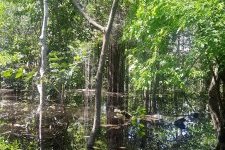
I hadn't intended to review this site but after reading Frédéric's review I thought I will add mine as well as there are both similarities and a few differences that may be of interest to others. I visited the site end of June 2024.
I took the night boat from Iquitos to the Peruvian-Brazilian-Colombian border, stayed one night in Colombian Leticia and then flew from Tabatinga to Manaus. I had considered the lengthy boat ride but decided against it as it seemed not very plannable (I could not find trustworthy schedules on internet), meaning I would have to plan about a week for it to 'fit' reliably into my schedule. And it seemed rather boring too. The afternoon propellor flight provided good views over the rainforest and the rivers and was reasonably priced. After a night in Manaus and exploring the parks in the outskirts, I took a late Sunday afternoon shared taxi to Novo Airao from near the bridge which left within 5 minutes and took about 3,5 hours.
I stayed 2 nights in the local hostel, I was the only guest in the dorm. I had initially booked a hotel but they cancelled a week before stating urgent renovations. Next morning I looked for a captain to take me to Anavilhanas. Prices quoted were 400 BRL but one captain whose number I got from the hostel, seemed very keen, and I negotioted 200 BRL. It was a 2 hours private trip, the captain was a kind …
Keep reading 0 comments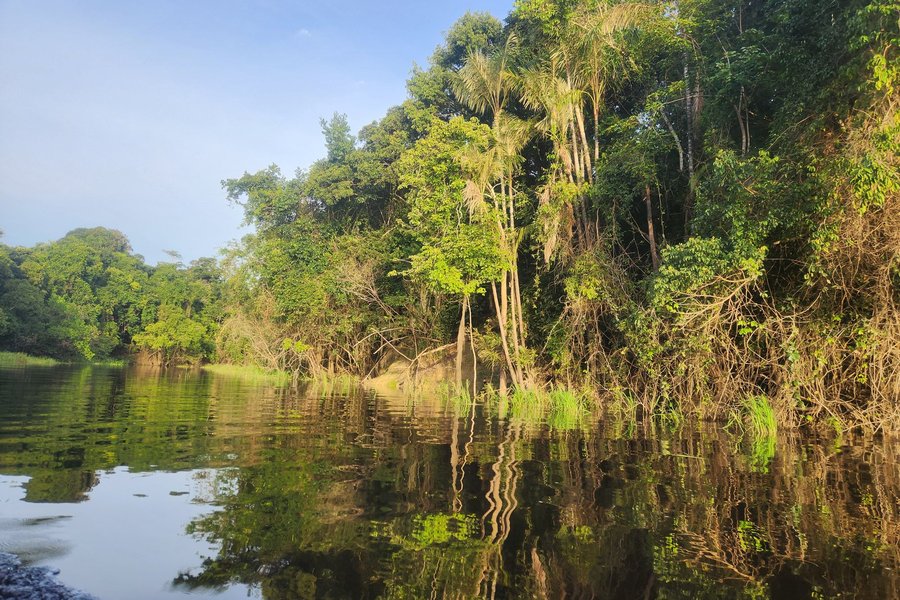
I worked hard to find an affordable way to visit this WHS. First, I contacted various tour operators in Manaus to inquire about a boat trip lasting a few days. However, I couldn't find any offer that didn't involve chartering an entire boat at an outrageous price. I then evaluated the possibility of spending a few days in a lodge rather than on a boat. Once again, the price put me off. I have the impression that the Uakari Lodge visited by Els would have been an excellent choice, but the price was high, and the logistics of getting to the lodge complicated matters considerably. Indeed, my Amazon journey didn't begin in Manaus.
It was from the Colombian town of Leticia, and its Brazilian neighbor Tabatinga, that I began my tour of the Amazon. From Tabatinga, it's possible to board cargo boats that also carry passengers on the Rio Solimoes. A few cabins are available, but most passengers bring their own hammock, which they hang on the hooks intended for this purpose. The price of the boat ticket includes three meals a day. My boat was also equipped with unlimited drinking water, toilets, showers and a small restaurant selling sandwiches, instant ramen and sweets. The trip from Tabatinga to Manaus takes four days and three nights (the reverse trip, against the current, is longer and more expensive). Passengers were mainly Brazilians, Colombians and Peruvians, but four other Western backpackers were also on board. We spent the four days of the …
Keep reading 0 comments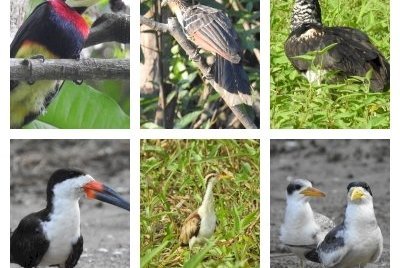
The Central Amazon Conservation Complex is a mostly contiguous area of parks and reserves in the northwest of Brazil, approximately in the center of the Amazon biome and the Amazon basin. You can dip your toe in with a one-day tour to Anavilhanas from the state capital of Manaus, but I opted for a more substantial visit to the sublocation ‘Mamirauá Reserve’. Situated over 500km west of Manaus, I first had to fly to Tefé. This is a bustling river port of 60,000 inhabitants with no road access. I was picked up for another 1.5 hours of travel by boat to the Uakari Lodge, where I stayed for 3 nights inside the Reserve.
The OUV of Mamirauá lies mainly in conserving a varzea forest, seasonally flooded by fertile “whitewater” rivers flowing from the Andes region. On our first day, we got to see which effect the floodings have on the local flora and fauna. We visited an island where the difference in water level can be up to 12 meters. The habitat is only suited to animals that can fly, swim or live in trees. You won’t find any tapirs or capybaras here…. Even the ants and termites build their nests high up in the trees instead of on the ground. Jaguars survive also up in the trees, but they are half the size of their cousins elsewhere.
The seasonal rise in water levels has an impact on the local people too. Mamirauá is inhabited by 14 small …
Keep reading 0 comments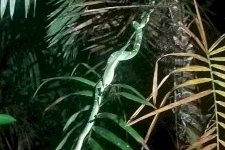
Amazon, heart of the planet, you'd think it's an instant 5 star visit... Not so much. The inscribed areas are rather poor, especially the ecological centers where they feed dolphins as a tourist attraction. To truly enter protected areas you will need to take a boat cruise into Jaú National Park. That means taking a 3h drive from Manaus, then traveling further in for at least a day and finally reach the ranger station.
The cruises are also super tourist driven, so I can't recommend them. Macaw watching, cayman catching, piranha fishing, visit to ruins (read: rubber baron remains, not exactly native) and shopping with a local tribe: Portuguese immigrants, not indigenous at all. To get anything more you will need to find a deep trekking tour instead and while I'm sure the Amazon is great, other places to see them are much better visits.
Keep reading 0 comments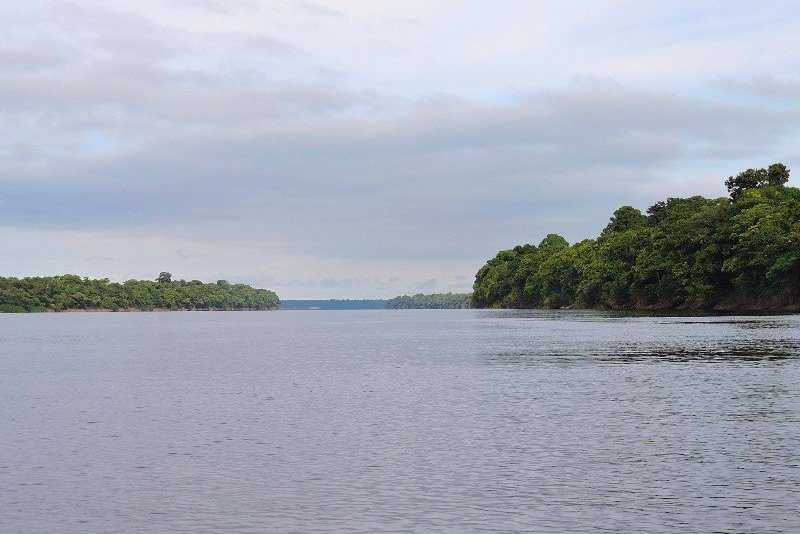
During carnival this year, unlike most Brazilians, I opted not to party, but, instead, to reach Central Amazon Conservation Complex, the WHS Brazil dedicated to its largest bioma.
First stop is Manaus, a large 2-million people city situated in the heart of Amazon forest. After that, with a rental car one must drive 200 km (paved roads in good condition) to a town called Novo Airão, from where you can easily visit the Anavilhanas National Park (it is no longer an Ecological Station since 2008). Anavilhanas comprises an average of 400 river islands and islets, depending on the dry or wet season. All of them are located within the Rio Negro (Black River), the largest blackwater river in the world and one of the most important tributary rivers of Amazon River.
Truly amazing! Rio Negro has pure and tepid waters, black-tea-like coloured, very good for bathing. If you have luck, one might sight a "boto rosa" (pink freshwater dolphin), one of the symbols of Amazon forest.
From Novo Airão, one can also reach another protected area of the WHS: Jaú National Park. It is the largest national park in Brazil and one of the largest in the world. Jaú has approximately the same size of Belgium.
3 hours in a boat are necessary to reach the park entrance and prior visiting authorisation is required. I opted not to sleep withing the forest - which is what some people do to have more time to visit the NP -, but still, …
Keep reading 0 comments
